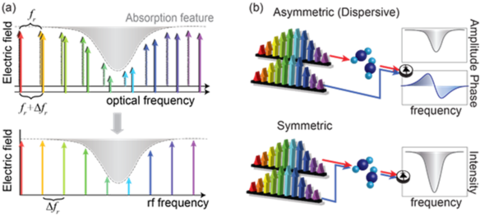Summary
Dual-comb spectroscopy is a technique that allows one to exploit the coherence, accuracy, and resolution of frequency combs for precision molecular spectroscopy with applications in both the laboratory and field. Our goal is to develop this technique and demonstrate its capabilities.
Description

In dual-comb spectroscopy two combs with slightly different repetition rates are interfered on a photodiode generating an rf comb composed of distinguishable heterodyne beats between pairs of optical comb teeth. This rf comb is easily recorded with modestly fast electronics and contains all the molecular absorption information from the original optical comb. The exact information recovered will vary depending on the system architecture, as shown above on the right. In the first configuration, one comb is transmitted through the sample and then interfered with the second “local oscillator” comb. This asymmetric approach is analogous to the “dispersive” FTIR technique and the full phase and amplitude response of the sample is measured. In the second, symmetric approach, both combs are transmitted through the sample. This approach is analogous to the typical FTIR configuration and measures only the sample’s absorption, but is more robust to turbulent measurement paths.
Fully stabilized frequency combs provide a broadband spectral output that is comprised of a series of narrow spectral lines or “teeth”. “Dual comb spectroscopy” provides one method to harness these properties for broadband spectroscopy. It allows the user to read-out the spectrum of a gas mixture on a comb tooth-by-tooth basis. Dual-comb spectroscopy (DCS) combines many of the strengths of conventional broadband spectroscopy and tunable laser spectroscopy into a single platform. NIST conducted the first demonstration of truly coherent DCS by use of two phase-locked fiber frequency combs in 2008. Since then, research in DCS has rapidly expanded (see the review article by Coddington et al., Optica, Vol. 3, Issue 4, 414-426 (2016)). DCS has a number of advantages over conventional spectrometers in the basic performance metrics of frequency resolution, accuracy, acquisition speed, and signal-to-noise ratio as well as in the potential for a compact, fieldable system. In recent years, research in the Fiber Sources and Applications group has focused on applying DCS to open-path detection of gases, exploiting DCS for both multi-species gas detection and the detection of broadband absorbers. We have successfully developed several generations of broadband near-infrared dual-comb spectrometer (1.4 – 2 microns) for kilometer-scale open path atmospheric measurements and deployed them in proof-of-principle experiments. The dual-comb spectrometer can run continuously for weeks over open air paths and accurately retrieve multiple atmospheric gases at sub-minute time resolution. Furthermore, it can operate over open paths to a retroreflector mounted on a flying quad-copter to enable spatial scanning or in a hub-and-spoke configuration for large-area monitoring. In a parallel effort, the team seeks to extend this capability into the mid-infrared spectral region (3 – 5 microns) where the larger organic molecules have much stronger cross sections. This work could lead to trace gas detection of broadband absorbers of interest to both the atmospheric science community and the defense community.


